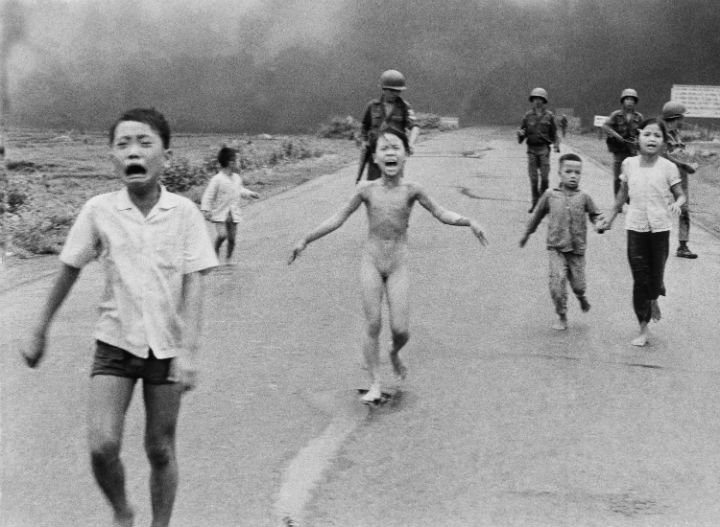WARNING: This post contains content some viewers may find disturbing. Discretion is advised.

VANCOUVER — It only took hours after first appearing online for the grim photograph of a lifeless body of 3-year-old Syrian refugee Alan Kurdi to become a symbol of the worst refugee crisis the world has seen in seven decades.
The image of Alan’s tiny corpse, having drifted onto the beach near the Turkish resort of Bodrum, has drawn comparisons to another heartbreaking image that opened the world’s eyes to horrors of war and humanitarian crises.
READ MORE: Will this photo help people grasp the desperation of Syrian refugees?
Kim Phuc was just 9 years old when a young Vietnamese photographer, Nick Ut, captured a photo of her running to safety, naked, after South Vietnamese planes dropped Napalm on her village of Trang Bang — where it was believed the Viet Cong may have crept in.
The napalm, a flammable liquid that sticks to the skin, burned the clothes off Kim’s body and scorched the young girl’s skin — leaving her with scars she still bears over 43 years later.
Speaking to Global News Thursday evening, Phuc said seeing the image of Alan touched her heart.
WARNING: This below image contains content some viewers may find disturbing. Discretion is advised. (Story continues below)

She believes the photo of Alan could make a difference in how the world is viewing the refugee crisis, much like Ut’s Pulitzer Prize-winning photo of her is said to have influenced Americans’ opinions of the long-running war in Vietnam — during which more than 3 million North Vietnamese, 250,000 South Vietnamese and more than 58,000 Americans lost their lives.
READ MORE: ‘Napalm girl’ photographer returns to Vietnam, this time using AP’s Instagram
Forty years after the end of the Vietnam War and the fall of Saigon, the world is faced with a humanitarian crisis that hasn’t been seen since the Second World War.
According to the United Nations, more than 59.5 million people have been forced to leave their homes in 2014 due to conflict and the threat of persecution.
And one of the biggest contributors to that unprecedented statistic is the civil war in Syria and the brutality of ISIS. More than 4 million Syrians have fled to neighbouring countries while a further 7.6 million have been displaced internally. More than 310,000 people are estimated to have died since the civil war broke out in 2011.
Alan Kurdi is a victim of the refugee crisis brought on by the war. His family reportedly fled to Turkey from their home in Kobani, just over the Syria-Turkey border, three years ago — before deciding to make the risky attempt to reach European Union (EU) territory.
Alan, his 5-year-old brother Ghalib and his mother Rehan all drowned when the boat in which they were trying to reach the nearby Greek island of Kos flipped over in the Aegean Sea.
Abdullah’s sister in British Columbia, Tima Kurdi, hoped they would one day be able to come to Canada.
READ MORE: ‘They didn’t deserve to die’: aunt of Syrian boys who drowned off Turkey
Only the father, Abdullah, survived after struggling to save his family. Instead, their deaths add to the steadily rising death toll of refugees, asylum seekers and migrants dying while attempting to reach Europe by sea.
As of Sept. 1, the International Organization for Migration had logged 2,643 deaths in the Mediterranean and Aegean Seas.
As EU leaders spar over how to cope with the more than 351,000 refugees, asylum seekers and migrants flowing into Europe from the Middle East and Africa, the photo has prompted calls for countries to resettle more people — in particular, those who have fled Syria.
READ MORE: Leaders disagree on action for Syrian refugees after seeing drowned boy photo
The Canadian government and the Conservative Party have been criticized for not acting fast enough to address the immediate need for refugee resettlement.
So far Canada has resettled 2,302 Syrian refugees — 1,300 to fulfill a commitment made in 2013 and 1,002 towards a January commitment to resettle 10,000 refugees over the next three years.
But NDP leader Tom Mulcair and Liberal leader Justin Trudeau said Canada needs to let in more refugees — and much sooner — than the Conservatives’ have planned. Both Trudeau and Mulcair on Thursday referenced Canada’s acceptance of some 60,000 boat people from Vietnam, Cambodia and Laos between 1979 and 1980.
Phuc and her husband also sought asylum in Canada in 1992, when the plane on which they were travelling to Moscow for their honeymoon stopped to refuel in Newfoundland.
Phuc later started the Kim Foundation, to help children affected by war and conflict, and is also a UNESCO Goodwill Ambassador for Peace. She received a Queen’s Golden Jubilee medal and the Order of Ontario.




Comments